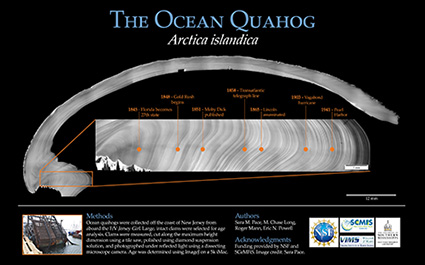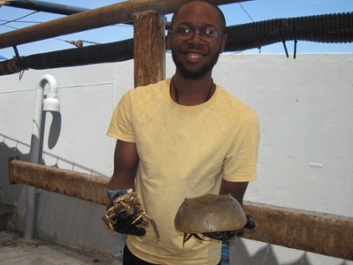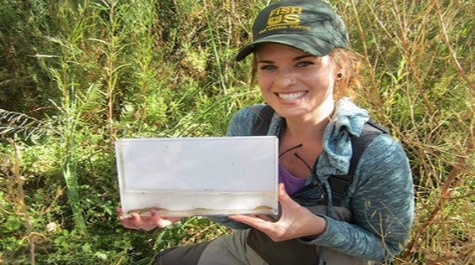Molluscan Ecology Education
Graduate education
Molluscan Ecology graduate students are enrolled in William & Mary's School of Marine Science graduate program and are part of the VIMS Department of Fisheries Science. Both Master's and Ph.D. students complete research projects that lead to Master of Science theses or Doctoral dissertations. These students are an integral part of the Molluscan Ecology program.
Student Research
Research experience is available to graduate, undergraduate and high school students working in the Molluscan Ecology Lab.
Alexandria Marquardt: Ph.D. candidate at the Virginia Institute of Marine Science, William & Mary
 Alex is an ecologist and PhD candidate in the Department of Fisheries Science at Virginia Institute of Marine Science working with Roger Mann studying Eastern oyster (Crassostrea virginica) biology and population dynamics in the Chesapeake Bay. Her work focuses primarily on marine invertebrates and addresses applied questions that directly inform management and restoration of harvested species. She hopes to engage with local communities and stakeholders to share knowledge, build relationships, and facilitate participation in scientific research.
Alex is an ecologist and PhD candidate in the Department of Fisheries Science at Virginia Institute of Marine Science working with Roger Mann studying Eastern oyster (Crassostrea virginica) biology and population dynamics in the Chesapeake Bay. Her work focuses primarily on marine invertebrates and addresses applied questions that directly inform management and restoration of harvested species. She hopes to engage with local communities and stakeholders to share knowledge, build relationships, and facilitate participation in scientific research.
Awards:
- Virginia Sea Grant Fellow 2022-2024
- Graduate Research Fellow
- Alex Marquardt's website
Presentations:
- Marquardt, A (2022, June). Distribution and demographics of fossil oysters on the Atlantic continental shelf. Wageningen University and Research. Yerseke, Netherlands
- Marquardt, A, R Mann, and E Powell. (2022). Distribution and Demographics of Fossil Oysters on the Atlantic Continental Shelf. AMERICAN FISHERIES SOCIETY, Spokane, WA, August 2022
- Marquardt, A, R Mann, and E Powell. (2022). Distribution and demographics of fossil oysters on the Atlantic continental shelf. Aquaculture. San Diego, CA. Alexandria Marquardt also won an award for this presentation. NATIONAL SHELLFISHERIES ASSOCIATION, San Diego, CA, March 2022
- Marquardt, A, M Southworth, and R Mann. (2022). Estimating post-settlement growth and survival in eastern oysters Crassostrea virginica in the Chesapeake Bay. Aquaculture. San Diego, CA. NATIONAL SHELLFISHERIES ASSOCIATION, San Diego, CA, March 2022
- Marquardt, A., M Southworth, N. Otto, M. Unger and R. Mann. (2022) Revisiting Rapana venosa in Hampton Roads, Chesapeake Bay as TBT Abates. NATIONAL SHELLFISHERIES ASSOCIATION, San Diego, CA, March 2022
- Marquardt, A., M. Southworth, and R. Mann. Post settlement survival in Eastern oysters (Crassostrea virginica) to inform management and restoration in the Chesapeake Bay. NATIONAL SHELLFISHERIES ASSOCIATION. Online via Zoom. March 2021
Undergraduate Opportunities
In partnership with the Science Center for Marine Fisheries, the Molluscan Ecology Lab can provide Research Experiences for Undergrads (REUs).
 Garrett Bellin is a rising sophomore at William & Mary studying applied statistics and data science. He is a researcher for the William & Mary Center for Geospatial Analysis, performing GIS analyses for various clients. Currently, he is working with Dr. Roger Mann using GIS mapping to find cod spawning locations and determine how they are affected by ocean warming trends. Using the DOPPIO and GLORYS ocean temperature datasets, ideal temperatures for cod spawning will be ascertained and overlaid with substrate and cod location data. Garrett hopes to be able to create GIS models that can predict future cod spawning grounds as ocean temperatures continue to rise. Policy changes could ultimately be affected which address the location and boundary of the Great South Channel Habitat Management Area near Nantucket.
Garrett Bellin is a rising sophomore at William & Mary studying applied statistics and data science. He is a researcher for the William & Mary Center for Geospatial Analysis, performing GIS analyses for various clients. Currently, he is working with Dr. Roger Mann using GIS mapping to find cod spawning locations and determine how they are affected by ocean warming trends. Using the DOPPIO and GLORYS ocean temperature datasets, ideal temperatures for cod spawning will be ascertained and overlaid with substrate and cod location data. Garrett hopes to be able to create GIS models that can predict future cod spawning grounds as ocean temperatures continue to rise. Policy changes could ultimately be affected which address the location and boundary of the Great South Channel Habitat Management Area near Nantucket.

Erin (Ellie) Carpenter is an undergraduate student studying biology and marine science at William & Mary. She is currently working with Dr. Roger Mann to use growth increments of clams on the Mid-Atlantic continental shelf to reconstruct bottom water temperatures. In addition to indicating past trends, this data could hopefully be used to predict future ocean temperature and clam growth trends in the midst of climate change.

Olivia (Livvie) Cohn is an undergraduate student veteran studying biology and marine science at William & Mary and is working with Dr. Roger Mann and Alex Marquardt in the VIMS Molluscan Ecology Lab. She has been assisting Alex in her PhD research by using image analysis to help track early growth and death rates of oyster spat. Livvie hopes to eventually take on individual research, and gain more experience engaging with the local community, and fisheries management.
 Ellen Rowe is an undergraduate student studying biology and marine science at William & Mary. She is also involved with William & Mary’s Center for Geospatial Analysis. She has created communication materials for conservation work and scientific research experience using her knowledge of Geographic Information System (GIS). Ellen is currently working with Dr. Roger Mann at VIMS and looking at oyster survey data. She is excited to combine her interests in marine science, GIS, and science communication during her REU project to present and share this research effectively.
Ellen Rowe is an undergraduate student studying biology and marine science at William & Mary. She is also involved with William & Mary’s Center for Geospatial Analysis. She has created communication materials for conservation work and scientific research experience using her knowledge of Geographic Information System (GIS). Ellen is currently working with Dr. Roger Mann at VIMS and looking at oyster survey data. She is excited to combine her interests in marine science, GIS, and science communication during her REU project to present and share this research effectively.
Partnership with W&M Center for Geospatial Analysis (CGA)
 The VIMS Molluscan Ecology (ME) Lab collaborates with the William & Mary Center for Geospatial Analysis (CGA), partnered by Dr. Shannon White, to provide geographic information system technical support for research projects. Currently, the ME Lab is the principal lead on a fisheries management project funded by the Science Center for Marine Fisheries (SCEMFIS) to map and analyze geospatial environmental data related to the northward movement of cod as it relates to temperature change, bathymetry, geologic habitat, and spawning range. This project investigates habitat suitability models for cod, as well as future projections for cod spawning ranges.
The VIMS Molluscan Ecology (ME) Lab collaborates with the William & Mary Center for Geospatial Analysis (CGA), partnered by Dr. Shannon White, to provide geographic information system technical support for research projects. Currently, the ME Lab is the principal lead on a fisheries management project funded by the Science Center for Marine Fisheries (SCEMFIS) to map and analyze geospatial environmental data related to the northward movement of cod as it relates to temperature change, bathymetry, geologic habitat, and spawning range. This project investigates habitat suitability models for cod, as well as future projections for cod spawning ranges.
In addition, this research provides a template to expand similar methods to other species and areas. Such collaborations are a win-win for the Molluscan Ecology Lab, fisheries managers, and students and fellows at the CGA. Applied research helps inform policymakers considering protected habitat boundaries and fisheries management decisions. As a result of this partnership, students gain rare experiences in research and real-world applications. Recently, Garrett Bellin, an REU Student, and Christina Sabochick, a CGA Research Fellow, were provided with an opportunity to present their research findings at the SCEMFIS Industry Advisory Board Meeting in Annapolis, Maryland.
Training Opportunities Provided by the VIMS Molluscan Ecology Lab: Graduate Students
Since 2015, several University of Southern Mississippi graduate students have been trained in shell aging techniques. Kelsey Kuykendall, Sara Pace, Leanne Poussard, Kathleen Hemeon, Jill Sower and Alyssa Leclaire received individualized tutorials ranging from weeks to months from the VIMS Molluscan Ecology Lab. They learned cutting, grinding, polishing, and aging techniques for various mollusc shells, thus contributing data to their graduate studies and furthering progress related to shellfish projects funded by the Science Center for Marine Fisheries (SCEMFIS).
- Hemeon, K. Ocean quahog (Arctica islandica) population dynamics: sex-based demographics and regional comparisons in the northwest Atlantic (2022). University of Southern Mississippi
- Kuykendall, K. Management strategy evaluation for the Atlantic surfclam, Spisula solidissima, using a fisheries economics model. (2015). University of Southern Mississippi.
- LeClaire, A.M., Powell, E.N., Mann, R., Hemeon, K.M., Pace, S.M., Sower, J.R. and T.E. Redmond (2022). Historical biogeographic range shifts and the influence of climate change on ocean quahogs (Arctica islandica) on the Mid-Atlantic Bight. The Holocene. 1-13.
- Pace, S. Evidence of multidecadal recruitment in ocean quahogs (Arctica islandica) in the western Atlantic Ocean. (2017). University of Southern Mississippi.
- Poussard, L. An Analysis of Dredge Efficiency for Surfclam and Ocean Quahog Commercial Dredges (2020). University of Southern Mississippi.
- Sower, J.R., Robillard, E., E.N. Powell, K.M. Hemeon, and R. Mann (2022) Defining Patterns in Ocean Quahog (Arctica Islandica) Sexual Dimorphism Along the Mid-Atlantic Bight. Journal of Shellfish Research, Vol 41, No. 3, 335-348
Kathleen Hemeon, USM, also co-authored a laboratory techniques manual that aids in the education of future students and technicians.
Non-Graduate Training
Sara Thomas learned to age scallops via shell isotope analysis and, in turn, contributed to instructional and field videos produced by the VIMS Molluscan Ecology Lab.
• Scallop Isotope Preparation (2019)
• Scallop Research Aboard the F/V Celtic (2019)
Stories Inside Shells - VIMS Marine Science Day
 VIMS Ph.D. candidates, Virginia Sea Grant Fellows, and mollusc enthusiasts, Kaitlyn Clark and Alex Marquardt, developed an educational booth titled “Stories Inside Shells” for the 21st Annual VIMS Marine Science Day (MSD). Posters and shells were provided to MSD attendees of all ages to examine and learn about how molluscs create annual growth rings similar to trees. The VIMS Molluscan Ecology Lab counts growth rings to determine age factors that are incorporated into fisheries management models.
VIMS Ph.D. candidates, Virginia Sea Grant Fellows, and mollusc enthusiasts, Kaitlyn Clark and Alex Marquardt, developed an educational booth titled “Stories Inside Shells” for the 21st Annual VIMS Marine Science Day (MSD). Posters and shells were provided to MSD attendees of all ages to examine and learn about how molluscs create annual growth rings similar to trees. The VIMS Molluscan Ecology Lab counts growth rings to determine age factors that are incorporated into fisheries management models.
See the VIMS Marine Science Day Photo Album here
Formal Graduate Molluscan Ecology Courses
Larval Ecology (MS658) - examines the Ecology of marine larval forms: spawning and development patterns; physical limitations on the fertilization process, feeding, nutrition, and mobility; size and parental investment, dispersal and metamorphosis, post-metamorphic survival. (3 credits)
Malacology (MS668) - examines the evolution of the molluscs from the Cambrian to the present, radiation to the current 80,000 or so species, and the functional morphology and ecology of each of the major taxonomic groups. The section on cephalopods is taught by Dr. Michael Vecchione of the USNM, Smithsonian. The course concludes with a field trip to the research collection at the Smithsonian Institution in Washington DC. (3 credits)




